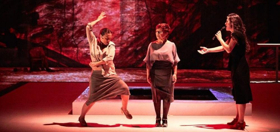Review: AVIGNON THEATRE FESTIVAL Presents GRITO PELAO by COMPAGNIE ROCÍO MOLINA

"I sometimes like to mix a bit of both," says Rocio Molina, as she dances a vibrant tarantella to her enraptured mother. Choreographer and dancer Molina constantly reaffirms this statement as dualities collide in the Avignon Theatre Festival's stately Cour du Lycée St. Joseph. The distant and the social, the masculine and the feminine, the matured and the innocent and, the intimate and the cosmic each reverberate with one another. Such contradictions are the progeny of Molina's identity crisis. Throughout the performance she ponders the nature of her soon to be motherhood alongside mother figure, dancer Lola Cruz, and singer Sílvia Pére Cruz. Thankfully talent is offered no contradiction in Grito Pelao, Molina's daring, if at times wandering, meditation.
Carlos Marquerie's set is made of three concentric squares. The innermost of these squares is a small pool of black water. Outside of this pool a large white platform expands to a larger boarder of white sand. It is a disarming testament to order. Upon Molina's entrance Marquerie immediately discards this void. He transfigures the barren space that welcomes us into an epic chasm of passion through his visionary projection and lighting design. Molina, now bathed in a delicate blue and held aloft by Carlo Gárate's haunting echoing sounds of the deep, rolls energy through her body and out her hands in curling spirals. Her mother then enters, accompanied by the band and singer Cruz. With a tranquil regard, mother takes hold of a rectangular ballet barre upstage left and conducts an elegant choreographic blend of ballet and flamenco. As she dances Molina imitates her motions downstage right, adding the flamenco percussion missing from Cruz's muted shining silver heels.
After this opening crescendo Grito Pelao becomes a parade of striking choreography, passionate music, and resonant images. The scenes that rely on the intimate power dynamic between mother and daughter are stirring. Molina dances gainfully with her mother as Cruz repeatedly belts, "Your mother is sensual." Mother seems to take this well at first with a delicate grin on her face. Then daughter and singer surround her with their own bodies' expressiveness. Mother's face becomes forlorn as the word sensual and the power of Molina's charging movement is at once an anthem to her, and an edifice to what her body perhaps no longer contains. There are also delightful moments of play as Molina spins a spider web of rhythm around her mother with cymbals. These moments, which bring flamenco's social dance construct to an investigation of daily relationships, are at turns sweet and melancholic. They are undergirded with confessional monologues, in which the three women address the audience about their individual journeys to motherhood. The vulnerability of their daily lives is in stark relief against their seeming impenetrability in dance. However, it is when the piece leaves the social world and enters into the archetypal experience of mother that Molina's iconoclasm becomes burdening.
The end of the performance is essentially a series of four codas. One: She puts a device next to her body allowing us to hear her heartbeat and then that of her growing baby. Two: The blue lighting and the sound of the deep she enters with are reprised. Only now the projection transforms into the sonogram of her fetus. Three: Molina strips nude and indulges in an exploration of the womb, finally diving into the pool center stage. Four: She exits the tub, is offered a robe and puts on shiny spandex shorts. Barefoot, she continues to dance. What's troubling is that these images aren't satisfying scenes. They're satisfying conclusions. With so many finales the shape of the piece, and by extension its thematic resonance, becomes evasive. This should not be the case, as it's clear Molina's understanding of self and capacity for performance expression is unassailable.
Grito Pelao is a showcase not just for Molina but also of the talents of all her collaborators. Credit for artistic direction is shared among herself, Pérez Cruz and Marquerie. Sílvia Pérez Cruz's voice has a powerful, warm wail. Her music and lyrics contain impassionate repetitions. Eduardo Trassierra is spellbinding on guitar. Carlos Montfort's mournful violin gives the vibrant performance a rich change of color. José Manuel Ramos "Oruco" compliments the dancers on stage with his kind voice and supportive rhythm on the compás. Carlos Gárate's electronic soundscapes assist wonderfully in the creating of a mythic and contemporary space. Dancer Lola Cruz's presence resonates with warmth whether dancing, recounting a story of her faith, or knitting upstage left in a folding chair. Costumes by Cecilia Molano quietly play with convention. Though she too at times is given center stage as in when Pérez Cruz enters wearing a large whicker cage skirt.
Grito Pelao will be performed over the coming months, including a performance in Paris where Rocío Pelao will then be seven months pregnant. If she is tired now, she does not show it. There is only vulnerability, passion, and talent radiating from her body. Her experience resonates far enough to the distant thoughts of motherhood that her scenic ponderings are simply redundant.
Photo Credit: Christophe Raynaud de LageReader Reviews

Videos

